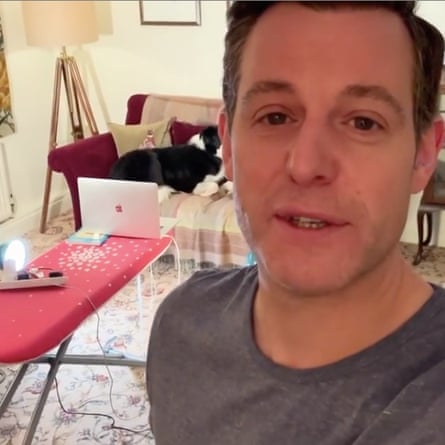Journalists presenting major news broadcasts from their homes ensures programmes remain on air throughout the coronavirus pandemic, but it also offers nosey viewers a chance to indulge one of Britain’s major obsessions: snooping around other people’s houses.
Krishnan Guru-Murthy, who has been co-presenting Channel 4 News from his home in recent days, is aware that people will be scrutinising what they can see in the background closely: “Obviously you don’t want to show very much of your house because you don’t want everyone judging your home decor. You need to create a corner that doesn’t cause too much offence or give away too many of the cracks in your wallpaper.”
Channel 4 News and other news programmes have attracted record audiences since the coronavirus outbreak, and the image of a journalist or guest expert broadcasting to the nation in front of a well-stocked bookshelf in a Victorian house has become a well-established trope.
“I spent some time the night before rearranging my front room to hide books because I knew that everyone would just want to see the bookshelves,” said Guru-Murthy. “If they’d seen my bookshelf they’d have seen a strange mix of Charlie and Lola, the Beastie Boys book and Ansel Adams.”
The presenter is currently accompanied by a single camera operator, with the rest of his family banished from a room usually used by his children to play video games. The hope is that he will soon be able to co-host an entire evening news bulletin without any technicians, as broadcasters reduce staffing levels to the bare minimum required to stay on air in the expectation of widespread illness.
Matt Baker, the co-host of the One Show, is contributing to the consumer programme from his sofa at home while isolating after a family member displayed potential Coronavirus symptoms. He has broadcast to millions of viewers using a MacBook propped up on an ironing board, with a book shoved underneath the computer to keep the shot level. Lighting was provided by a couple of table lamps and a powerful garage light. Baker has accepted that for many viewers “the star of the show” was his sheepdog Bob, who made an appearance with him on his sofa.

Technological advances mean reliable television-quality broadcasts can be created by patching together a home broadband connection with a device that combines six 4G sim cards to produce a consistent and stable signal. With the country in lockdown, television guest bookers also say it has never been easier to find people to appear on programmes, drawn by large audiences and lack of other commitments.
Other presenters appearing remotely include Susanna Reid, the co-host of ITV’s Good Morning Britain, who has been presenting on the programme from her home after going into precautionary self-isolation, which means she can no longer sit in the studio next to Piers Morgan. She has appeared in front of a blank grey wall, avoiding the risk of showing too much of her home.

National radio programmes are increasingly being presented from their hosts’ homes, with the only major difference often being with the slight echo that comes from being sat in a house rather than an expensively soundproofed studio.
Various Today programme presenters are contributing from home, and BBC Radio 4’s The World At One bulletin has tested doing so over an ISDN connection from Sarah Montague’s kitchen table. She was equipped with a couple of laptops, a microphone, some headphones and a basic audio mixer, but said the programme was going to be presented from BBC broadcasting house in the short term. “It was easy for me but more challenging for producers so putting it off until essential and systems improved,” she said.
Like millions of others, working from home today. My kitchen table is now @BBCWorldatOne studio. #bbcworld pic.twitter.com/Ejs6cQYoRG
— Sarah Montague (@Sarah_Montague) March 17, 2020
Guru-Murthy said his main tips for television presenters preparing to broadcast to millions of people from their homes was to disconnect devices that could make noise and tell family members to stay away, ensuring there is no recreation of the moment when Professor Robert Kelly was interrupted by his toddler on BBC News in 2017.
“The biggest risk now is the neighbours know what’s going on,” said Guru-Murthy. “Having warned people I would be doing it, I have a couple of friends who would think it very funny to ring the doorbell.”
